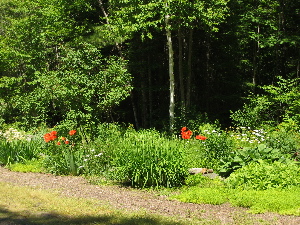Tulips should be dead-headed(remove spent flower)
The grass can be mowed when it reaches 3-4 inches (sorry, but
it IS that time again!) When you do cut it, set the mower to 2 1/2 to 3 inches.
Hold off mulching until the soil is warm, or you'll just keep
the cold in!
You can now plant lettuce, beans, corn and carrots right in the
soil.
Tomatoes can be planted when the lilacs bloom. You might sprinkle
a teaspoon of Epsom salts into the hole where they go to provide magnesium.
Marigolds, zinnias and even nasturtiums are good to plant in and around
your vegetables as well as the flower beds. They repel insects!
You can begin to plant gladiolas at 2 week intervals.
This is a good time to weed dandelions, before they flower and set seed!
You can fertilize any bulbs that are up.
Stake your peonies before they get too big. This applies to other tall growing plants. Get the stakes in the ground before they get too tall. (Remember to try rebar.)
Cut back your tall perennials like bee balm and phlox to control their height.
Harvest rhubarb by grabbing it at the base of the stalk and pulling firmly away from the crown, twisting just a bit. Be sure to throw the leaves into the compost as they are poisonous!
You can prune your spring blooming shrubs just as soon as the flowers have faded.
Dead head your lilacs.
Check your lilies for red lily leaf beetles. CRUSH them!
Don't forget to dead head your bulbs as well. Leave the foliage, but take out the spent flower heads.
Have you got Hosta's? Are there slugs chewing them? Try this solution, if you haven't already.
Combine 9 parts water to common household ammonia and spray it on the hosta just before dark. When the slugs hit this, they will dissolve!
Check the apple, cherry, and other fruit trees for nests of tent caterpillars. As soon as the tender, new leaves emerge, so will the caterpillars. Their destruction is just awful! Try blasting them with a strong stream of water from the hose. Bt will also work if you can get it up there. Maybe the use of a sprayer will be practical in this case. I also understand that the Praying Mantis is a big time enemy of tent caterpillars. Perhaps you should order some of those! They should be released into the affected tree at the same time the caterpillars emerge. If you place them before their dinner appears, they will find another yard to in which to chow down.
If you have to spray insecticide, do it AFTER bloom to protect the bees!
Plant Annuals no sooner than May 30
th!




